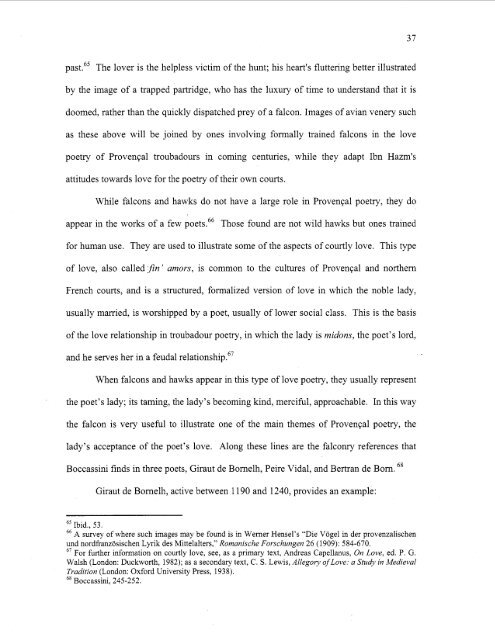Dissertation on Birds of Prey and the Sport - the Falconry Heritage ...
Dissertation on Birds of Prey and the Sport - the Falconry Heritage ...
Dissertation on Birds of Prey and the Sport - the Falconry Heritage ...
Create successful ePaper yourself
Turn your PDF publications into a flip-book with our unique Google optimized e-Paper software.
past.65 The lover is <strong>the</strong> helpless victim <strong>of</strong> <strong>the</strong> hunt; his heart's fluttering better illustrated<br />
by <strong>the</strong> image <strong>of</strong> a trapped partridge, who has <strong>the</strong> luxury <strong>of</strong> time to underst<strong>and</strong> that it is<br />
doomed, ra<strong>the</strong>r than <strong>the</strong> quickly dispatched prey <strong>of</strong> a falc<strong>on</strong>. Images <strong>of</strong> avian venery such<br />
as <strong>the</strong>se above will be joined by <strong>on</strong>es involving formally trained falc<strong>on</strong>s in <strong>the</strong> love<br />
poetry <strong>of</strong> Provenqal troubadours in coming centuries, while <strong>the</strong>y adapt Ibn Hazm's<br />
attitudes towards love for <strong>the</strong> poetry <strong>of</strong> <strong>the</strong>ir own courts.<br />
While falc<strong>on</strong>s <strong>and</strong> hawks do not have a large role in Provenqal poetry, <strong>the</strong>y do<br />
appear in <strong>the</strong> works <strong>of</strong> a few poets.66 Those found are not wild hawks but <strong>on</strong>es trained<br />
for human use. They are used to illustrate some <strong>of</strong> <strong>the</strong> aspects <strong>of</strong> courtly love. This type<br />
<strong>of</strong> love, also called'fin' amors, is comm<strong>on</strong> to <strong>the</strong> cultures <strong>of</strong> Provenqal <strong>and</strong> nor<strong>the</strong>rn<br />
French courts, <strong>and</strong> is a structured, formalized versi<strong>on</strong> <strong>of</strong> love in which <strong>the</strong> noble lady,<br />
usually married, is worshipped by a poet, usually <strong>of</strong> lower social class. This is <strong>the</strong> basis<br />
<strong>of</strong> <strong>the</strong> love relati<strong>on</strong>ship in troubadour poetry, in which <strong>the</strong> lady is mid<strong>on</strong>s, <strong>the</strong> poet's lord,<br />
<strong>and</strong> he serves her in a feudal relati<strong>on</strong>ship.67<br />
When falc<strong>on</strong>s <strong>and</strong> hawks appear in this type <strong>of</strong> love poetry, <strong>the</strong>y usually represent<br />
<strong>the</strong> poet's lady; its taming, <strong>the</strong> lady's becoming kind, merciful, approachable. In this way<br />
<strong>the</strong> falc<strong>on</strong> is very useful to illustrate <strong>on</strong>e <strong>of</strong> <strong>the</strong> main <strong>the</strong>mes <strong>of</strong> Provenqal poetry, <strong>the</strong><br />
lady's acceptance <strong>of</strong> <strong>the</strong> poet's love. Al<strong>on</strong>g <strong>the</strong>se lines are <strong>the</strong> falc<strong>on</strong>ry references that<br />
Boccassini finds in three poets, Giraut de Bornelh, Peire Vidal, <strong>and</strong> Bertran de Born.<br />
65 Ibid., 53.<br />
Giraut de Bornelh, active between 1190 <strong>and</strong> 1240, provides an example:<br />
66 A survey <strong>of</strong> where such images may be found is in Werner Hensel's "Die Vogel in der provenzalischen<br />
und nordfranzosischen Lyrik des Mittelalters," Romanische Forschungen 26 (1909): 584-670.<br />
67 For fur<strong>the</strong>r informati<strong>on</strong> <strong>on</strong> courtly love, see, as a primary text, Andreas Capellanus, On Love, ed. P. G.<br />
Walsh (L<strong>on</strong>d<strong>on</strong>: Duckworth, 1982); as a sec<strong>on</strong>dary text, C. S. Lewis, Allegory <strong>of</strong>love: a Study in Medieval<br />
Traditi<strong>on</strong> (L<strong>on</strong>d<strong>on</strong>: Oxford University Press, 1938).<br />
Boccassini. 245-252.


